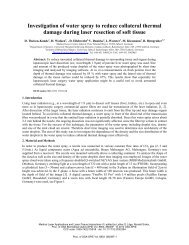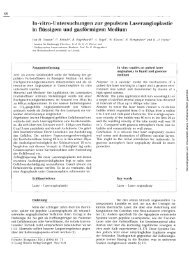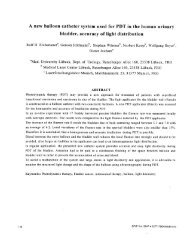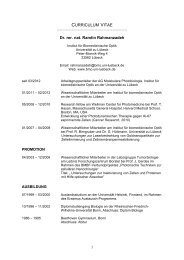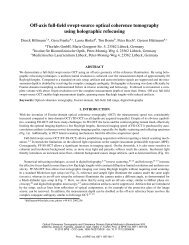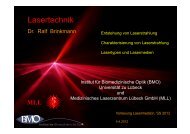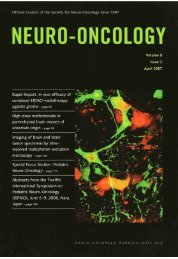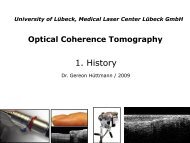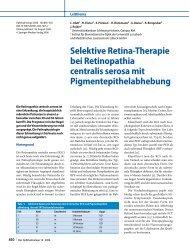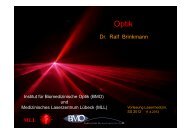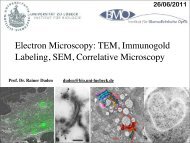Invited p aper Mechanisms of femtosecond laser nanosurgery of ...
Invited p aper Mechanisms of femtosecond laser nanosurgery of ...
Invited p aper Mechanisms of femtosecond laser nanosurgery of ...
You also want an ePaper? Increase the reach of your titles
YUMPU automatically turns print PDFs into web optimized ePapers that Google loves.
1044 Applied Physics B – Lasers and Opticsthrough heat accumulation during application <strong>of</strong> series <strong>of</strong><strong>femtosecond</strong> pulses may also play a role [231, 235], butcannot be separated from and are probably dominated bythe chemical effects <strong>of</strong> the free electrons. Thermal effects,and especially the resulting thermoelastic stresses, will playa prominent role for low repetition rates and larger pulse energies[236–238], where they can even lead to the formation <strong>of</strong>voids [179, 235, 239]. Void formation in solid dielectrics requiresa larger plasma energy density than bubble formationin aqueous media but, due to the strongly nonlinear energy deposition,only a slight increase in irradiance. This explains thesimilarity <strong>of</strong> the optical breakdown thresholds for both groups<strong>of</strong> materials.We conclude that with the advent <strong>of</strong> compact and reliable<strong>femtosecond</strong> <strong>laser</strong> technology, nanoprocessing <strong>of</strong> biologicalcells and tissues has gained new exciting perspectives.A deeper understanding <strong>of</strong> the working mechanisms will helpto further optimize this technique, to open new avenues formicro- and nanomanipulation, and to find new applicationsfor functional studies on cells and small organisms.An important challenge for future research is the timeresolvedinvestigation <strong>of</strong> the <strong>laser</strong>-induced events, especiallyfor those cases where bubble formation is involved in dissection,and the assessment <strong>of</strong> the consequences <strong>of</strong> the bubbles’oscillations for the integrity, metabolism, and viability<strong>of</strong> the affected cells. To achieve optimum precision and predictability<strong>of</strong> effects produced at 1kHzand allow for on-linedosimetry, techniques for real-time feedback on the formation<strong>of</strong> transient bubbles with lifetimes <strong>of</strong> 1 µs or smaller mustbe established. A measurement <strong>of</strong> the bubble oscillation amplitudewill also allow us to determine their size and thus toassess the potential damage range <strong>of</strong> the <strong>laser</strong> effects. Forsurgery using oscillator pulses at MHz repetition rates, bubbleoscillations are probably not relevant. Here, bubble growth isa much slower process driven by the cumulative production <strong>of</strong>non-condensable gas and can more easily be monitored.A significant shortcoming <strong>of</strong> all present models <strong>of</strong> opticalbreakdown in biomaterials is the lack <strong>of</strong> consideration <strong>of</strong> thespecific absorption properties <strong>of</strong> the biomolecules or stainscontained in the aqueous medium. Future models should considerthe role <strong>of</strong> heating by linear absorption and the modification<strong>of</strong> multiphoton processes by intermediate energy levelslocated within the band gap for water. These levels could allowfor multiphoton processes <strong>of</strong> lower order, leading to freeelectrongeneration and bond breaking in the biomolecule atlower irradiances than those required for optical breakdown <strong>of</strong>water.ACKNOWLEDGEMENTS This work was sponsored by theUS Air Force Office <strong>of</strong> Scientific Research through its European Office<strong>of</strong> Aerospace Research and Development under Grant No. FA8655-02-1-3047, and, in parts, by the German Bundesministerium für Bildung undForschung under Grant No. 13N8461. We appreciate stimulating discussionson the modeling <strong>of</strong> plasma formation with Paul Kennedy (US AirForce Optical Research Laboratory, Brooks City Base, San Antonio, USA),Nadezhda Bulgakova (Institute <strong>of</strong> Thermophysics, SB RAS, Novosibirsk,Russia), Rieko Verhagen (Philips Research, Eindhoven, The Netherlands),Cord Arnold (Laserzentrum Hannover, Germany), and Norbert Linz (Institute<strong>of</strong> Biomedical Optics, University <strong>of</strong> Lübeck, Germany). We thank S.B.Kiselev (Colorado School <strong>of</strong> Mines, Golden, USA) for providing tabulateddata <strong>of</strong> the kinetic spinodal [163] used for calculating the bubble-formationthresholds.REFERENCES1 Y.R. Shen, The Principles <strong>of</strong> Nonlinear Optics (Wiley, New York 1984)2 A. Vogel, V. Venugopalan, Chem. Rev. 103, 577 (2003)3 V. Venugopalan, A. Guerra, K. Nahen, A. Vogel, Phys. Rev. Lett. 88,078 103 (2002)4 K. König, I. Riemann, P. Fischer, K. Halbhuber, Cell. Mol. Biol. 45,195 (1999)5 C.B. Schaffer, A. Brodeur, J.F. García, E. Mazur, Opt. Lett. 26, 93(2001)6 K. Minoshima, A.M. Kowalevicz, I. Hartl, E. Ippen, J.G. Fujimoto,Opt. Lett. 26, 1516 (2001)7 W. Watanabe, T. Asano, K. Yamada, K. Itoh, J. Nishii, Opt. Lett. 28,2491 (2003)8 S. Taccheo, G. Della Valle, R. Osellame, G. Cerullo, N. Chiodo, P. Laporta,O. Svelto, A. Killi, U. Morgner, M. Lederer, D. Kopf, Opt. Lett.29, 2626 (2004)9 R.F. Steinert, C.A. Puliafito, The Nd:YAG Laser in Ophthalmology(Saunders, Philadelphia 1986)10 A. Vogel, W. Hentschel, J. Holzfuss, W. Lauterborn, Ophthalmology93, 1259 (1986)11 I. Ratkay-Traub, I.E. Ferincz, T. Juhasz, R.M. Kurtz, R.R. Krueger,J. Refract. Surg. 19, 94 (2003)12 A. Heisterkamp, T. Mamom, O. Kermani, W. Drommer, H. Welling,W. Ertmer, H. Lubatschowski, Graef. Arch. Clin. Exp. 241, 511 (2003)13 T. Juhasz, F.H. Loesel, R.M. Kurtz, C. Horvath, J.F. Bille, G. Mourou,IEEE J. Sel. Top. Quantum Electron. 5, 902 (1999)14 M. Han, L. Zickler, G. Giese, M. Walter, F.H. Loesel, J.F. Bille,J. Biomed. Opt. 9, 760 (2004)15 A. Vogel, K. Nahen, D. Theisen, IEEE J. Sel. Top. Quantum Electron.2, 847 (1996)16 A. Heisterkamp, T. Ripken, H. Lubatschowski, T. Mamom, W. Drommer,H. Welling, W. Ertmer, Appl. Phys. B 74, 419 (2002)17 W. Liu, O. Kosareva, I.S. Golubtsov, A. Iwasaki, A. Becker, V.P. Kandidov,S.L. Chin, Appl. Phys. B 76, 215 (2003)18 S.S. Mao, F. Quéré, S. Guizard, X. Mao, R.E. Russo, G. Petite,P. Martin, Appl. Phys. A 79, 1695 (2004)19 J. Kasparian, J. Solle, M. Richard, J.-P. Wolf, Appl. Phys. B 79, 947(2004)20 M. Kolesik, E.M. Wright, J.V. Moloney, Phys. Rev. Lett. 92, 253 901(2004)21 C.L. Arnold, A. Heisterkamp, W. Ertmer, H. Lubatschowski, Appl.Phys. B 80, 247 (2005)22 U. Fuchs, U.D. Zeitner, A. Tünnermann, Opt. Express 13, 3852 (2005)23 R.K. Saiki, D.H. Gelfand, S. St<strong>of</strong>fel, S.J. Scharf, R. Higuchi, G.T. Horn,K.B. Mullis, H.A. Erlich, Science 239, 487 (1988)24 A.F. Markham, Brit. Med. J. 306, 441 (1993)25 S.A. Bustin, J. Mol. Endocrinol. 25, 169 (2000)26 G. Isenberg, W. Bielser, W. Meier-Ruge, E. Remy, J. Microsc. 107, 19(1976)27 W. Meier-Ruge, W. Bielser, E. Remy, F. Hillenkamp, R. Nitsche,R. Unsöld, Histochem. J. 8, 387 (1976)28 K. Schütze, H. Pösl, G. Lahr, Cell. Mol. Biol. 44, 735 (1998)29 K. Schütze, G. Lahr, Nat. Biotechnol. 16, 737 (1998)30 G. Lahr, Lab. Invest. 80, 1477 (2000)31 K. Lorenz, Mechanismen des Katapultierens biologischer Strukturenmit UV-Laserpulsen, Diploma Thesis, University <strong>of</strong> Applied ScienceLübeck (2004) [in German]. Accessible through vogel@bmo.uniluebeck.de32 C.E.Sims,G.D.Meredith,T.B.Krasieva,M.W.Berns,B.J.Tromberg,N.L. Allbritton, Anal. Chem. 700, 4570 (1998)33 K.R. Rau, A. Guerra, A. Vogel, V. Venugopalan, Appl. Phys. Lett. 84,2940 (2004)34 M.W. Berns, J. Aist, J. Edwards, K. Strahs, J. Girton, P. McNeil,J.B. Kitzes, M. Hammer-Wilson, L.-H. Liaw, A. Siemens, M. Koonce,S. Peterson, S. Brenner, J. Burt, R. Walter, P.J. Bryant, D. van Dyk,J. Coulombe, T. Cahill, G.S. Berns, Science 213, 505 (1981)35 H. Liang, W.H. Wright, S. Cheng, W. He, M.W. Berns, Exp. Cell Res.204, 110 (1993)36 K.O. Greulich, Micromanipulation by Light in Biology and Medicine(Birkhäuser, Basel Boston Berlin 1999)37 K. König, I. Riemann, W. Fritsche, Opt. Lett. 26, 819 (2001)38 S. Sato, E. Higurashi, Y. Taguchi, H. Inaba, Appl. Phys. B 54, 531(1992)39 K. Schütze, A. Clement-Sengewald, Nature 368, 667 (1994)



